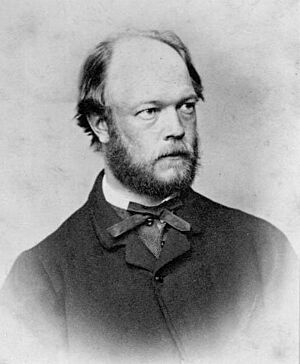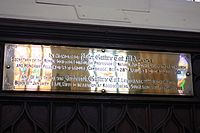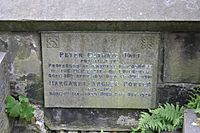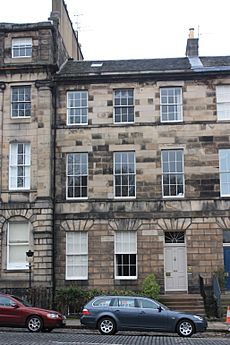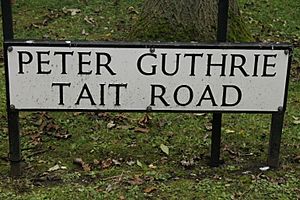Peter Tait (physicist) facts for kids
Quick facts for kids
Peter Guthrie Tait
|
|
|---|---|
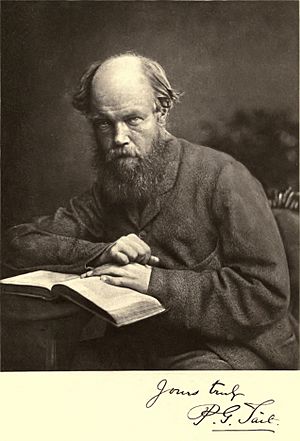
Photograph of Tait in 1870, with signature
|
|
| Born | 28 April 1831 Dalkeith, Scotland
|
| Died | 4 July 1901 (aged 70) Edinburgh, Scotland
|
| Alma mater | |
| Known for |
|
| Awards |
|
| Scientific career | |
| Fields | Mathematical physics |
| Institutions | |
| Academic advisors | William Hopkins |
Peter Guthrie Tait (born April 28, 1831 – died July 4, 1901) was an important Scottish scientist. He was a mathematical physicist, which means he used math to understand how the physical world works. He was also one of the first people to study thermodynamics, which is about heat and energy.
Tait is famous for a science textbook called Treatise on Natural Philosophy. He wrote this book with another famous scientist, Lord Kelvin. He also did important early work on knot theory, which is a branch of mathematics that studies knots.
His work on knot theory helped create a new area of math called topology. In a field called graph theory, his name is linked to Tait's conjecture. He also helped name the Tait–Kneser theorem, which is about circles that touch a curve.
Contents
Early Life and Education
Peter Guthrie Tait was born in Dalkeith, Scotland, on April 28, 1831. He was the only son of Mary Ronaldson and John Tait. His father worked for the Duke of Buccleuch.
Peter went to Dalkeith Grammar School and then Edinburgh Academy. He studied Math and Physics at the University of Edinburgh. Later, he went to Peterhouse, Cambridge, a college at Cambridge University. He was a top student, graduating first in his class in 1852.
After college, he stayed at Cambridge for two more years. He worked as a fellow and teacher. Then, he became a professor of mathematics at Queen's College, Belfast. There, he met Thomas Andrews. They worked together on studies about ozone and how electricity affects gases. Andrews also introduced Tait to Sir William Rowan Hamilton and his ideas about quaternions.
Scientific Discoveries
In 1860, Tait became a professor of natural philosophy at the University of Edinburgh. He held this important position until just before he died. His first solo science paper was published in 1860.
Much of his early work was about math, especially quaternions. Quaternions are a type of number system used in advanced math and physics. Tait became the main expert on them after their creator, William Rowan Hamilton. He wrote two textbooks about quaternions. One was called Elementary Treatise on Quaternions (1867). The other was Introduction to Quaternions (1873), which he wrote with help from his old teacher, Philip Kelland.
Tait also did original work in both math and experimental physics. In 1864, he wrote a paper on thermodynamics, the study of heat and energy. After that, he made many important contributions to this field. In 1871, he highlighted the importance of the "dissipation of energy" principle. This is also known as the second law of thermodynamics.
In 1873, he gave a speech about thermoelectricity at Cambridge University. In the same year, he showed his famous thermoelectric diagram to the Royal Society of Edinburgh.
Later, he worked with James Dewar on "Charcoal Vacua" experiments. This helped him understand how the Crookes radiometer works. From 1879 to 1888, he did difficult experiments. He studied how to correct thermometers used deep in the ocean by the Challenger expedition. He also studied how much water, glass, and mercury can be squeezed under pressure. This work led to the Tait equation, which is used to figure out how dense liquids are under pressure.
Between 1886 and 1892, he wrote papers about the kinetic theory of gases. This theory explains how gases behave based on the movement of their tiny particles. One of his papers had the first proof of the equipartition theorem. This theorem explains how energy is shared equally among particles in a mix of gases. He also studied how objects hit each other and for how long.
Tait did many other studies. A collection of his papers fills three large books! He did all this work while also teaching at the university. For example, in 1880, he worked on the Four color theorem. This theorem states that any map can be colored with only four colors so that no two neighboring regions have the same color.
Books and Collaborations
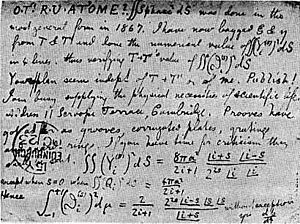
Peter Tait wrote many books and articles. His first book, published in 1856, was about how particles move. He also wrote clear books on thermodynamics, heat, light, and the properties of matter. He even wrote a popular book of lectures called Recent Advances in Physical Science.
He is most famous for the book Treatise on Natural Philosophy, which he wrote with Lord Kelvin. They started planning this book soon after Tait became a professor in Edinburgh. They wanted it to cover all of physical science, starting with how things move and then covering matter, heat, light, and electricity. However, they stopped working together after about 18 years. They realized they could work better on their own. But their friendship lasted for the rest of Tait's life.
Tait also worked with Balfour Stewart on a book called The Unseen Universe. This was followed by Paradoxical Philosophy. Tait also wrote articles for the ninth edition of the Encyclopædia Britannica. He wrote about light, mechanics, quaternions, and thermodynamics. He also wrote about the lives of Hamilton and James Clerk Maxwell.
Later Years and Legacy
Peter Guthrie Tait passed away in Edinburgh on July 4, 1901. He is buried in the churchyard of St John's Episcopal Church, Edinburgh.
Knot Theory and Conjectures
The Tait conjectures are three ideas Tait proposed while studying knots. These ideas are about different types of knots, like alternating knots (where the string goes over and under in a regular pattern) and chirality (whether a knot looks different when flipped). All of Tait's conjectures have been proven true. The last one, the Flyping conjecture, was proven in 1991 by Morwen Thistlethwaite and William Menasco.
Private Life
Tait was married to Margaret Archer Porter. She had several talented siblings. Her sister Jane married Alexander Crum Brown, a Scottish chemist.
Peter Tait loved to play golf. Two of his seven children, Frederick Guthrie Tait and John Guthrie Tait, became excellent amateur golf champions. Tait was also a great all-around athlete. He even played rugby union for Scotland! In 1891, Tait used a science idea called the Magnus effect to explain why a golf ball curves when it spins. His daughter Edith married Rev. Harry Reid, who later became a bishop.
His son William Archer Porter Tait became a civil engineer.
Recognition and Memorials
Tait was a lifelong friend of James Clerk Maxwell, another very famous scientist. A painting of Tait is kept at the James Clerk Maxwell Foundation museum in Edinburgh.
There are also several portraits of Tait by the artist Sir George Reid. One of these paintings is at the National Galleries of Scotland. Another portrait was put up at Peterhouse, Cambridge in 1902.
One of the teaching positions in the Physics Department at the University of Edinburgh is named the Tait professorship.
A road at the University of Edinburgh's King's Buildings campus is named Peter Guthrie Tait Road in his honor.
See also
 In Spanish: Peter Guthrie Tait para niños
In Spanish: Peter Guthrie Tait para niños
- Dowker–Thistlethwaite notation
- Four color theorem
- Homoeoid
- Medial graph
- Nabla symbol


